Working with acclaimed talents such as Bill Sienkiewicz and Dave Mazzucchelli, Frank Miller wrote four of the most talked about comics of all time, and they all came out in 1986
After completing a groundbreaking and critically lauded run on Marvel’s Daredevil in 1982, Frank Miller’s star was on the rise. DC Comics coaxed him away from Marvel by offering him complete creative freedom on Ronin, a mashup of dystopian science fiction and Kurosawa-esque samurai action. Ronin was a year or two early to ride the wave of interest in cyberpunk literature spurred by the publication of William Gibson’s Neuromancer in 1984, and it struggled to find an audience in a comics marketplace that was still dominated by superhero books.
Miller’s published output over the next two years was fairly light, consisting mainly of cover artwork for reprints of his Spider-Man and Daredevil work, a 4-page story in DC’s Superman #400, and a Captain America story published in Marvel Fanfare #18 that seems likely to have been an unused story, possibly completed years earlier and held in inventory until published to capitalize on Miller’s newfound fame.
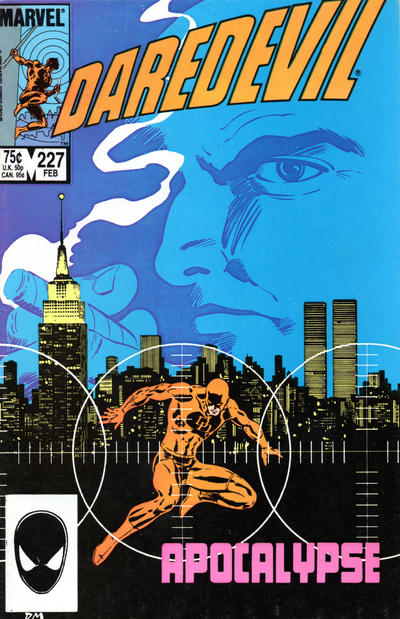
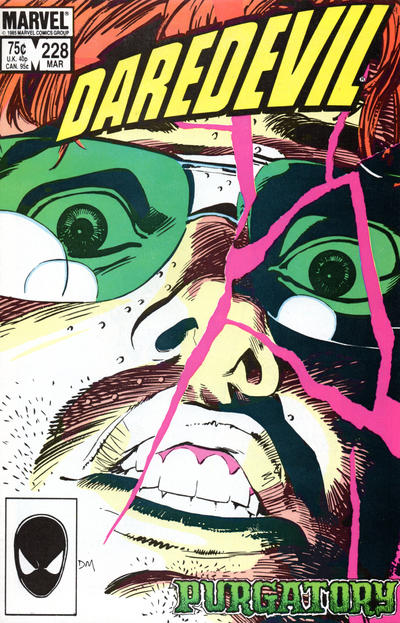
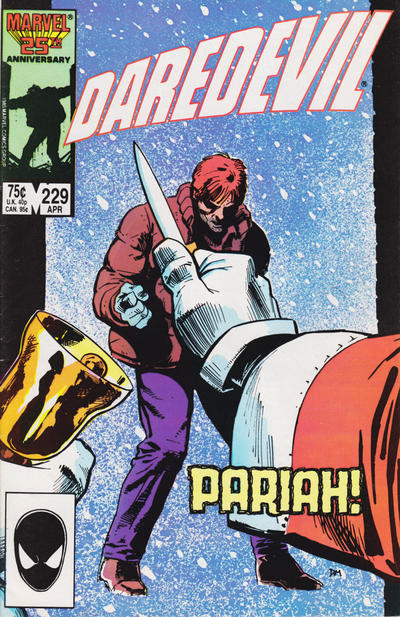
Daredevil issues 227, 228 and 229, cover art by Dave Mazzucchelli. © Marvel.
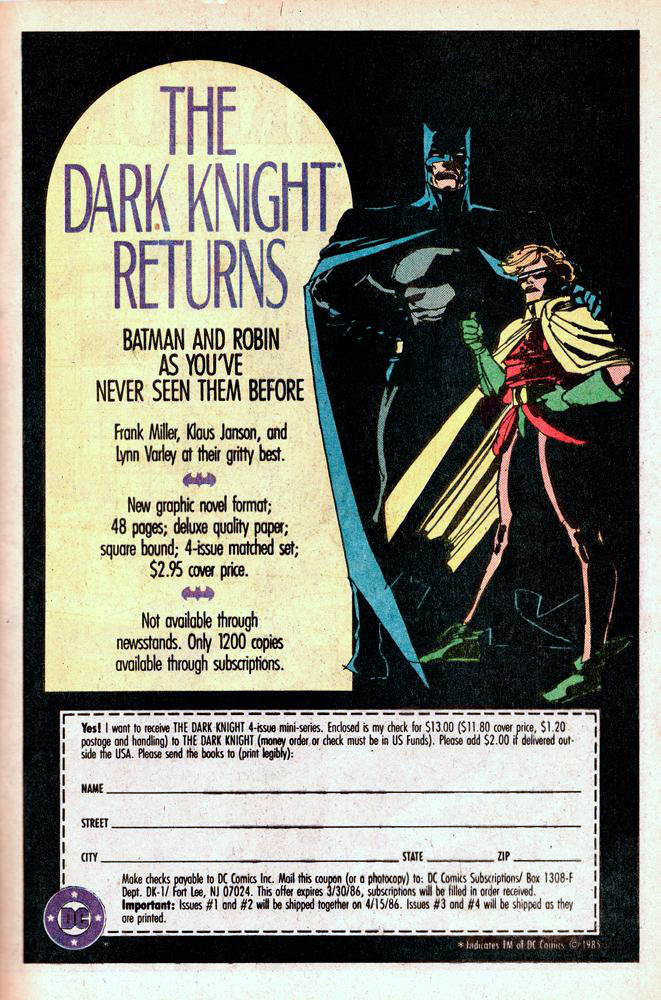
Miller does not appear to have been idle, however. He came back to Daredevil with a vengeance in 1985, first with a fill-in script for #219 before taking over writing the title in earnest with issue #227, the start of the acclaimed Born Again story that was meant to reset the character’s status quo. But his return to the character that made him famous wasn’t his biggest project moving into 1986 – February saw publication of the first issue of Batman: The Dark Knight Returns, written and drawn by Miller (with Klaus Janson and Lynn Varley) and quite possibly the most influential superhero comic book of all time. At the very least it was the book that made mainstream media sit up and take notice of what was going on in comics.
But that wasn’t enough for Frank Miller, as he would also collaborate with superstar artist Bill Sienkiewicz on Elektra: Assassin and Daredevil: Love and War, two books that would blur the lines between comic book illustration and fine art. And he finished off the year by retelling the origin of Batman in Batman: Year One, solidifying a basis for the character that would be used and built on by comics creators and filmmakers for decades to come.
All in all there were 19 full-length (or longer) comic books published between January and December 1986 with Frank Miller’s name in the credits (plus two with cover art by Miller). Let’s take a look at them month by month.
January 1986
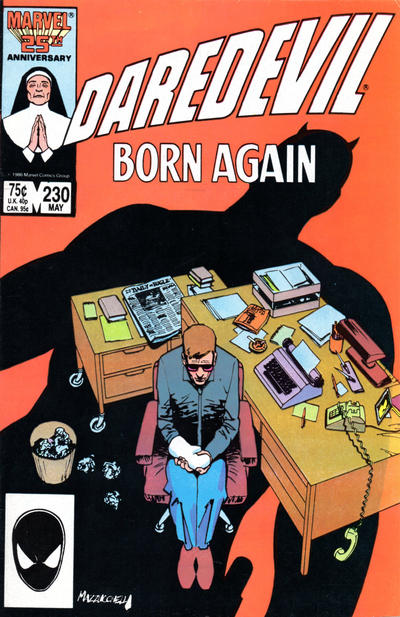
Daredevil #230 (cover date May 1986) “Born Again”
Story by Frank Miller; artwork by Dave Mazzucchelli; color by Max Scheele; letters by Joe Rosen.
This issue builds on the story that has unfolded over the previous three issues. At this time, paperback collections of comic book stories were still relatively uncommon (although that will change drastically in the next year as The Dark Knight, Watchmen and Maus take the bookstores by storm) so the single issue was how most readers would experience the material. There is even an awareness of when each issue would be published; the preceding issue, published in December, takes place over Christmas, and winter’s harshness giving way to spring’s renewal is a major theme of the story as a whole.
With the assumption that each issue is somebody’s first, Miller and his collaborator, artist Dave Mazzucchelli, give us a two-page summary of the story so far, ingeniously told from the point of view of the book’s principal supporting characters. Daredevil’s old flame Karen Page has fallen on hard times, finding herself in Mexico living the life of a drug addict and performing in what is hinted at being adult films to support her habit. In a moment of supreme weakness, she sells the knowledge that Daredevil is secretly blind lawyer Matt Murdock. This information reaches the Kingpin, New York’s number one crime lord, who uses his connections to completely destroy Murdock’s life: he is disbarred from practicing law, his assets are frozen and his home destroyed. The resulting trauma sends Murdock to the streets in a haze of paranoia, but he manages to evade the Kingpin’s final death blow, instead finding himself badly wounded, lying helpless in a homeless shelter.
Meanwhile, Murdock’s former law partner Foggy Nelson has unknowingly taken a job with one of the Kingpin’s shell companies, and reluctantly begun a romance with Murdock’s ex-girlfriend Glori, a photographer from Ireland. The final supporting character is Ben Urich, a newspaper reporter who knows the truth about Matt Murdock and the Kingpin’s frame-up, but has been intimidated into silence, his fingers broken by one of the Kingpin’s goons.
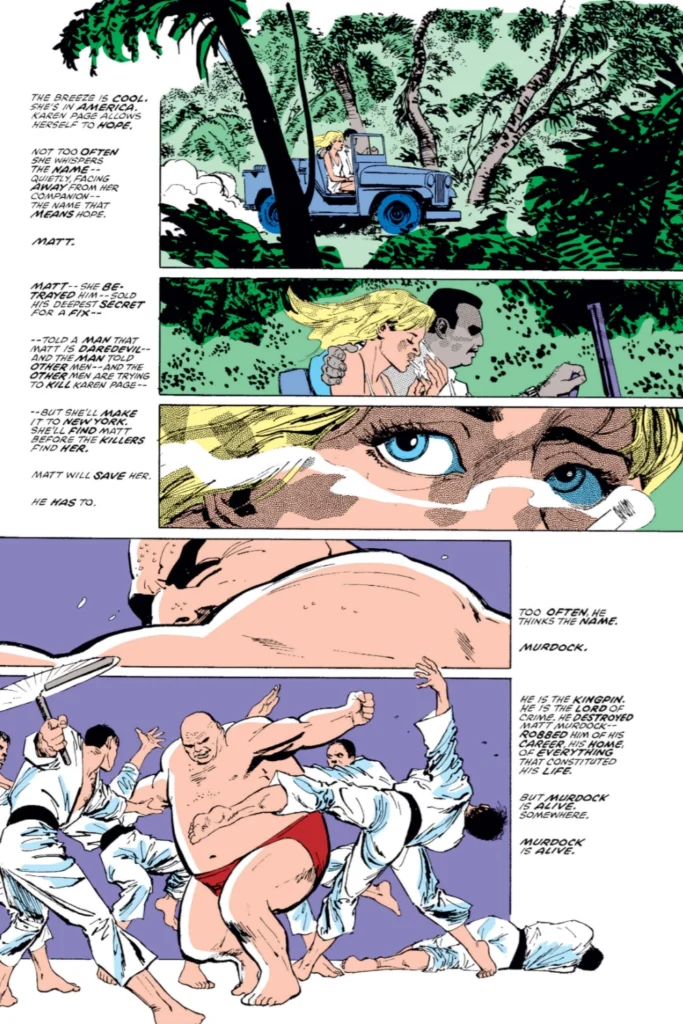
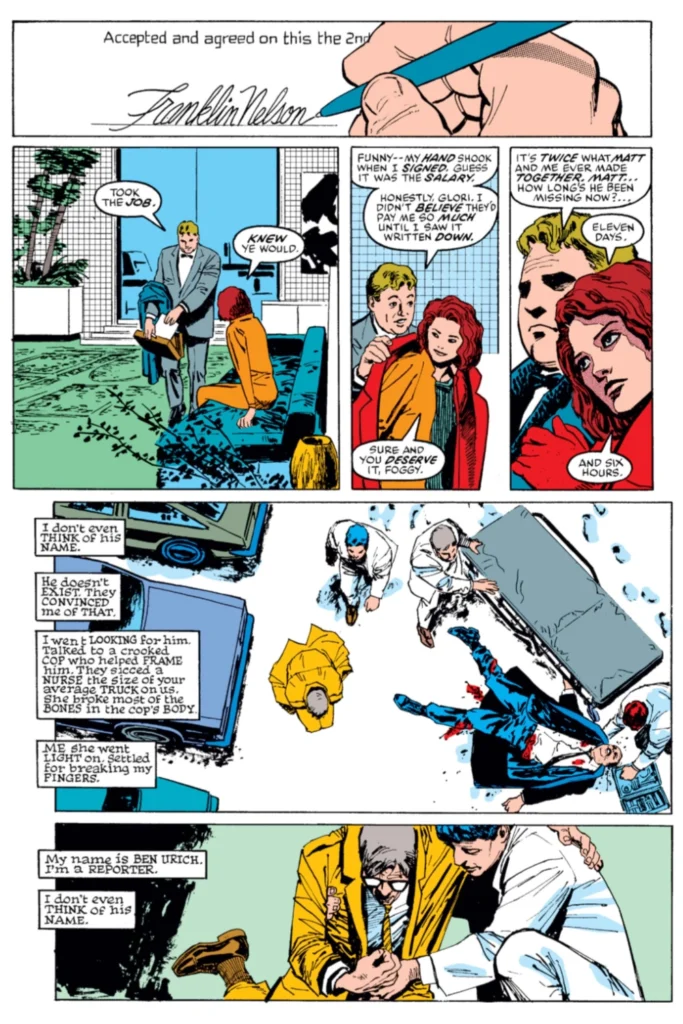
Pages 3 and 4 from Daredevil #230. © Marvel.
It’s a very grim story, but Miller seems aware of that, cutting the bleakness of Matt and Karen’s stories with a combination of gallows humor from Ben Urich and the surprisingly sweet romance between Foggy and Glori. Miller has a gift for using humor to both build and relieve tension simultaneously, as in this sequence where Ben Urich listens to an informant get murdered over the phone while the Daily Planet newsroom bustles with sarcasm around him:
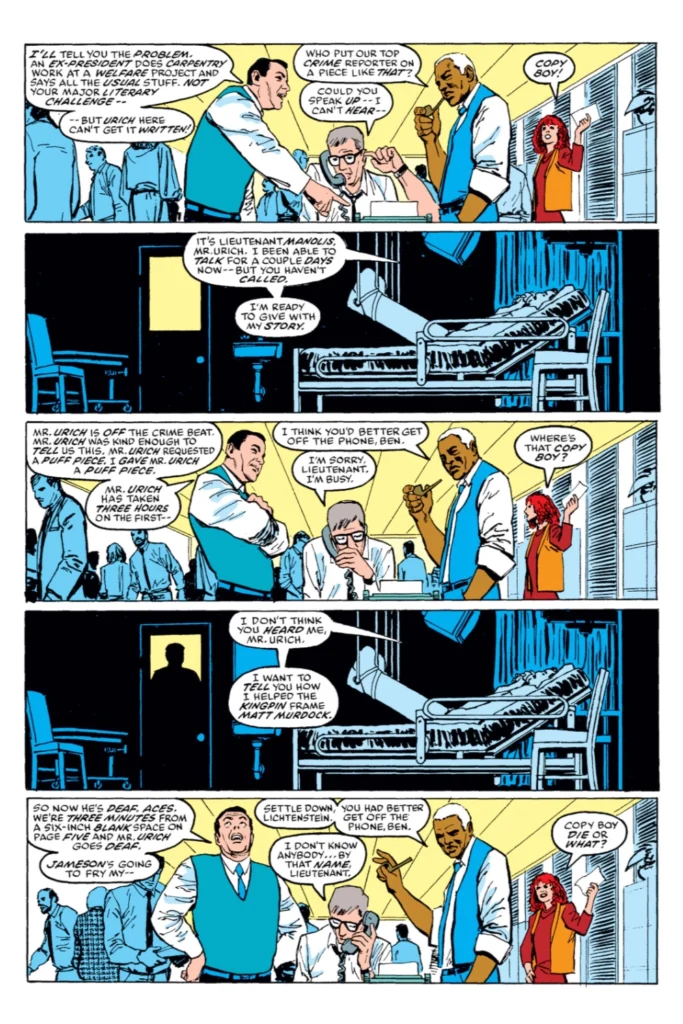
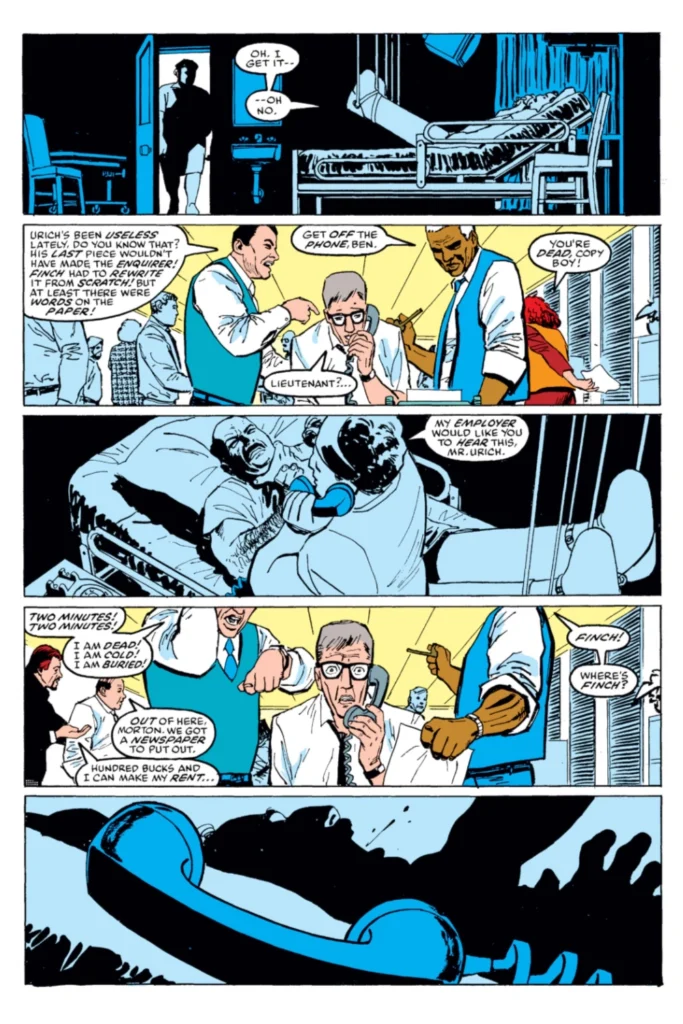
Pages 13 and 14 from Daredevil #230. © Marvel.
It should be noted that illustrator Dave Mazzucchelli deserves a lot of the credit for how effective this story is. His work is utterly flawless, blending effortless realism with just enough exaggeration to make the characters expressive and the action fluid. It lends a naturalism to the story that might have been missing had Miller chosen to do the artwork himself.
The issue deftly moves between the parallel storylines, with Karen finally reaching out to Foggy for help, the Kingpin being driven to distraction by Murdock’s survival and disappearance, and Ben Urich finally resolving to tell his story and not give in to intimidation. All the while, Murdock recovers in a church basement homeless shelter, and determines that the nun taking care of him is his long lost mother…
February 1986
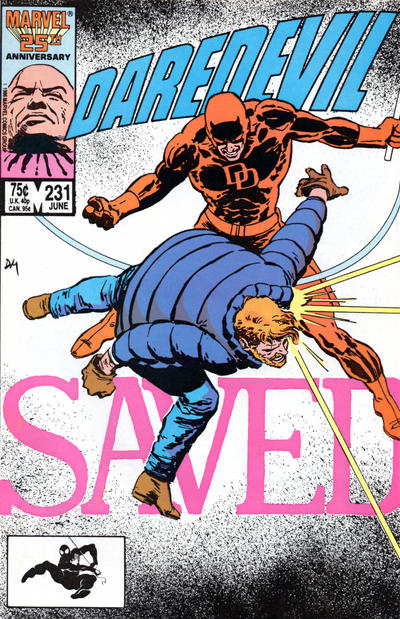
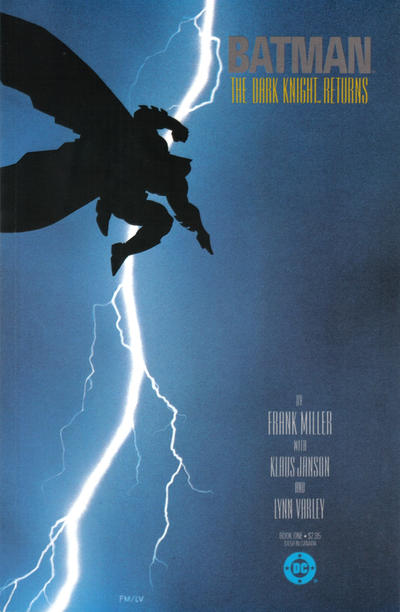
Daredevil #231 (cover date June 1986) “Saved”
Story by Frank Miller; artwork by Dave Mazzucchelli; color by Max Scheele; letters by Joe Rosen.
Having spent the previous four issues tearing Matt Murdock down, Miller and Mazzucchelli now build him back up. After recovering from his mental and physical ordeal, Murdock begins shadowing Ben Urich, who has begun writing an exposé on the Kingpin. Meanwhile, despite criticism from members of his criminal organization over his apparent obsession with Murdock, the Kingpin moves forward with a complicated series of schemes to further discredit his enemy.
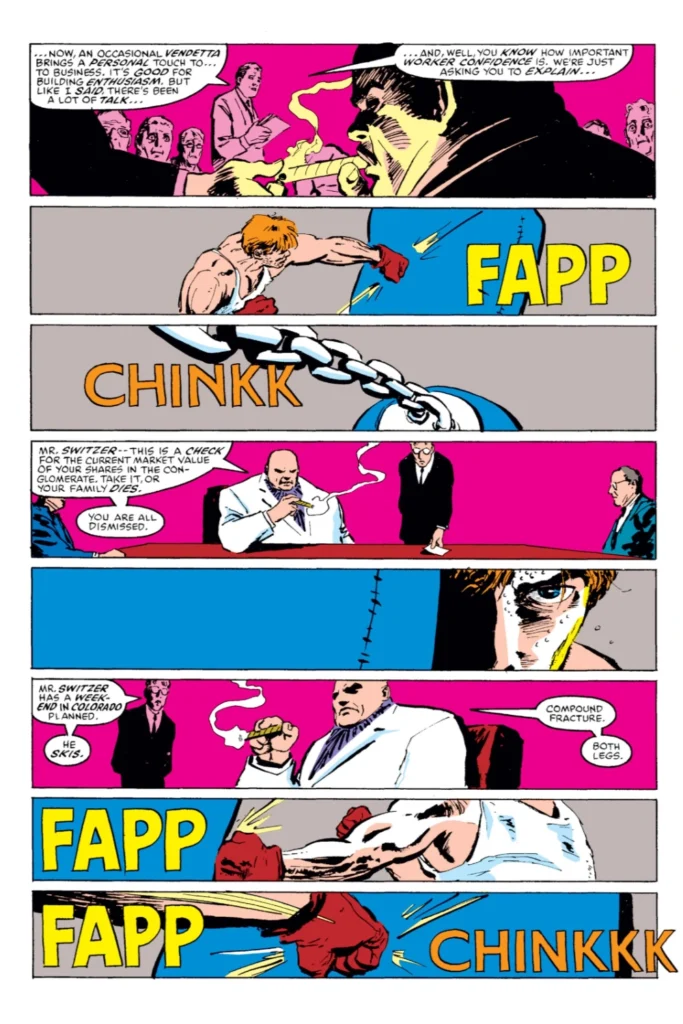
From Daredevil #231. © Marvel.
The theme of this issue seems to be the contrast between Murdock’s newfound simplicity and the Kingpin’s veneer of respectability. A great sequence of panels illustrates this by showing the Kingpin arguing with his board of directors and mapping out his convoluted plan, while Murdock pounds away at a punching bag. Events soon lead to a showdown between the Kingpin’s goons, Murdock, and Karen’s drug pusher. In the course of the battle, Murdock defeats an impostor in a Daredevil uniform, perhaps symbolic of his rejection of the “old,” complicated Daredevil in favor of a new, simpler identity.
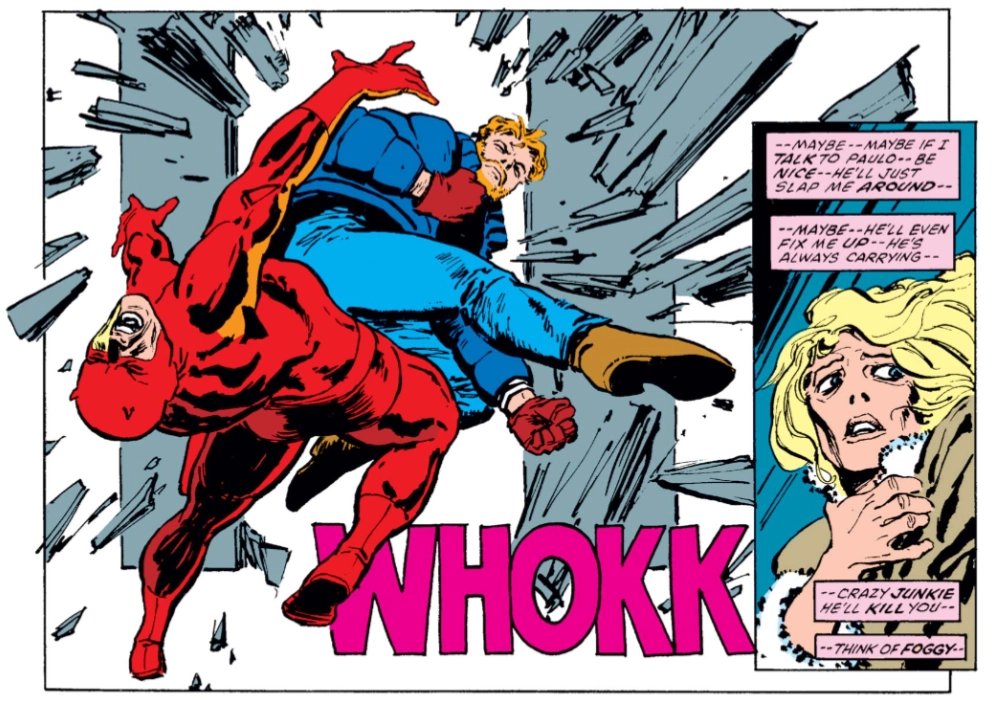
From Daredevil #231. © Marvel.
Mazzucchelli deftly illustrates the violent, action-packed confrontation, but gives extra weight to Murdock and Karen’s reunion, reinforcing that their relationship is at the heart of the story, and the real catalyst for Murdock’s renewal.
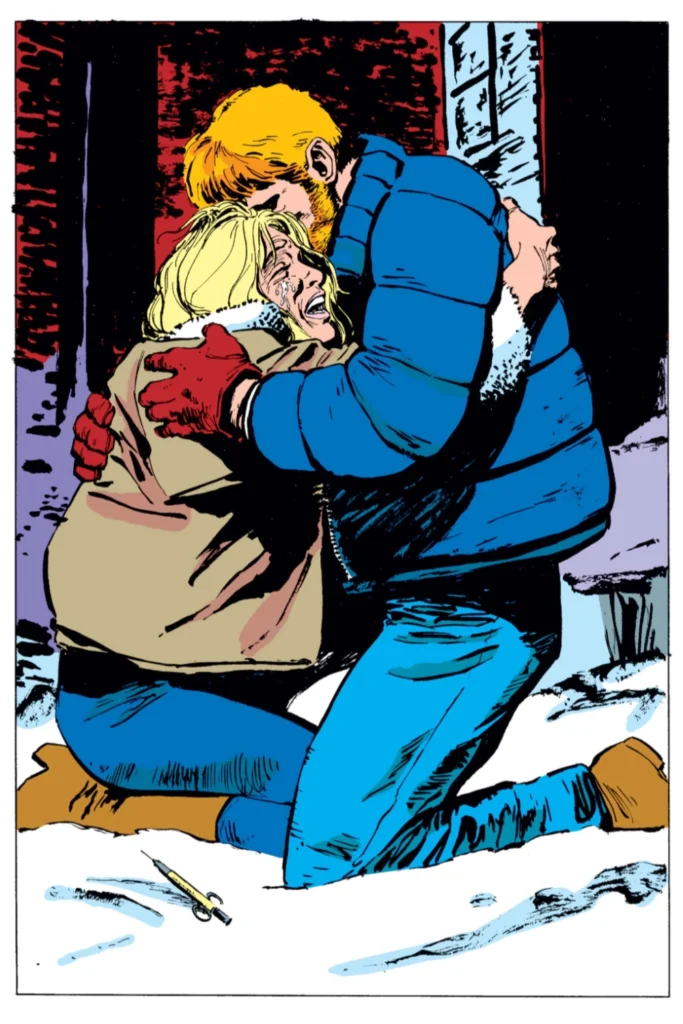
From Daredevil #231. © Marvel.
Batman: the Dark Knight Returns Book One “The Dark Knight Returns”
Story and pencils by Frank Miller; inks by Klaus Janson; colored by Lynn Varley; letters by John Costanza.
There is a very good reason why The Dark Knight Returns took the comics world by storm, and reached beyond it to garner a flood of media attention and influence a generation of comics artists and filmmakers. Even re-reading it now, in 2024, it is electrifying. It takes advantage of the cultural familiarity with Batman and his cast of characters that comes from 50 years of comics publishing (and a very popular, if possibly ill-conceived, television series). He can assume that we know just enough about these characters that he doesn’t have to spend time explaining them – he can just get on with telling the story he wants to tell, a story about a retired Batman who can’t figure out what to do with himself, in a world gone mad that clearly still needs him.
And the way he tells it, jumping between tiny panels full of dialogue and huge, full-page illustrations that serve as snap-shots of the larger-than-life action — the cinematic approach he uses is nothing short of astonishing. It’s no surprise that Batman filmmakers from Tim Burton to Christopher Nolan have been swiping shots from The Dark Knight Returns for the past 35 years.
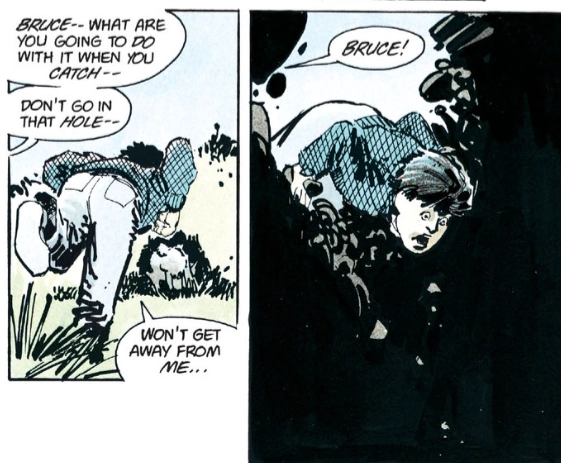
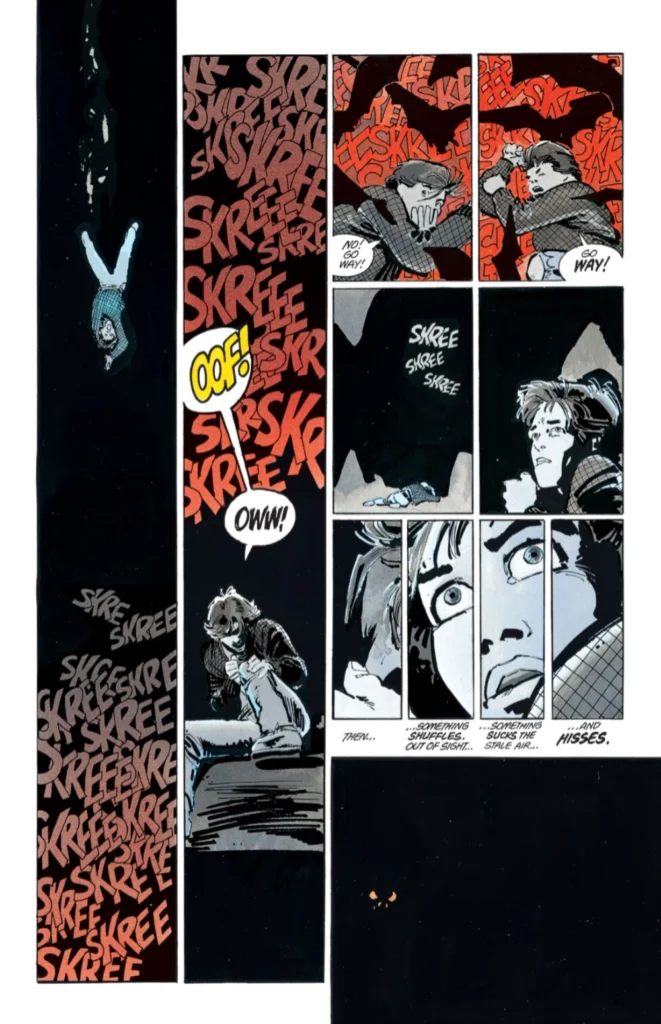
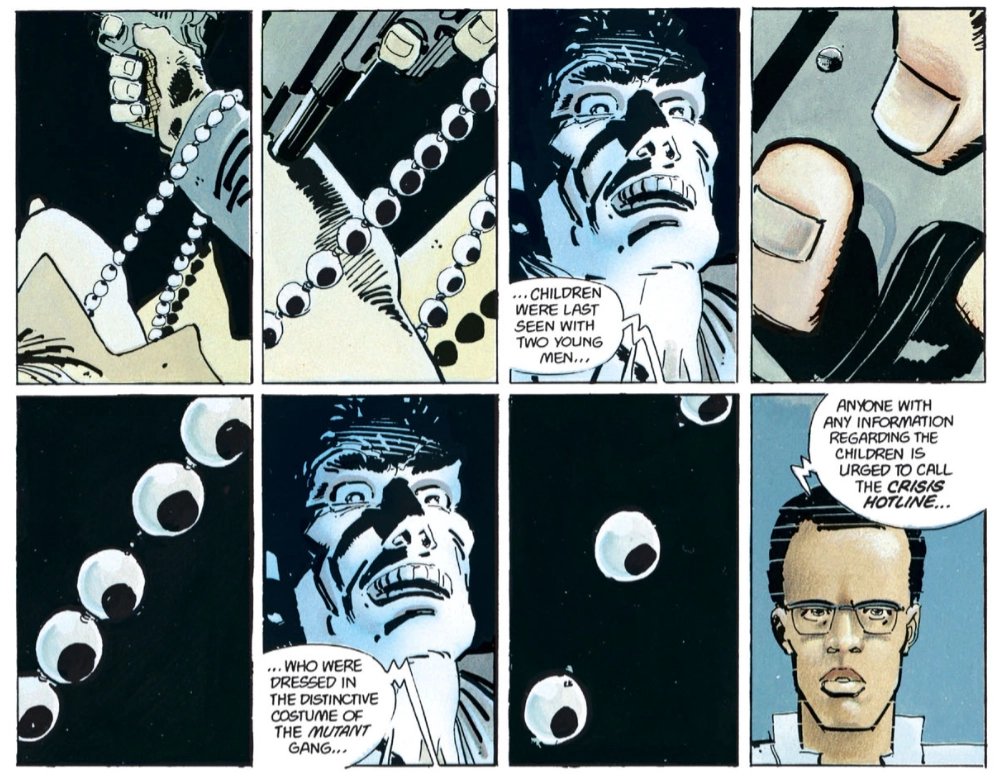
Scenes from Batman: the Dark Knight Returns book one. © DC Comics.
A few things in particular struck me upon re-reading the first issue, apart from the fact that it really is just as exciting as it was 38 years ago. One is his use of silhouette to increase the pace and make the action clearer. He would later take this approach to an extreme in Sin City, but here the technique is used sparingly, and oddly serves to make the action more clear by removing detail.
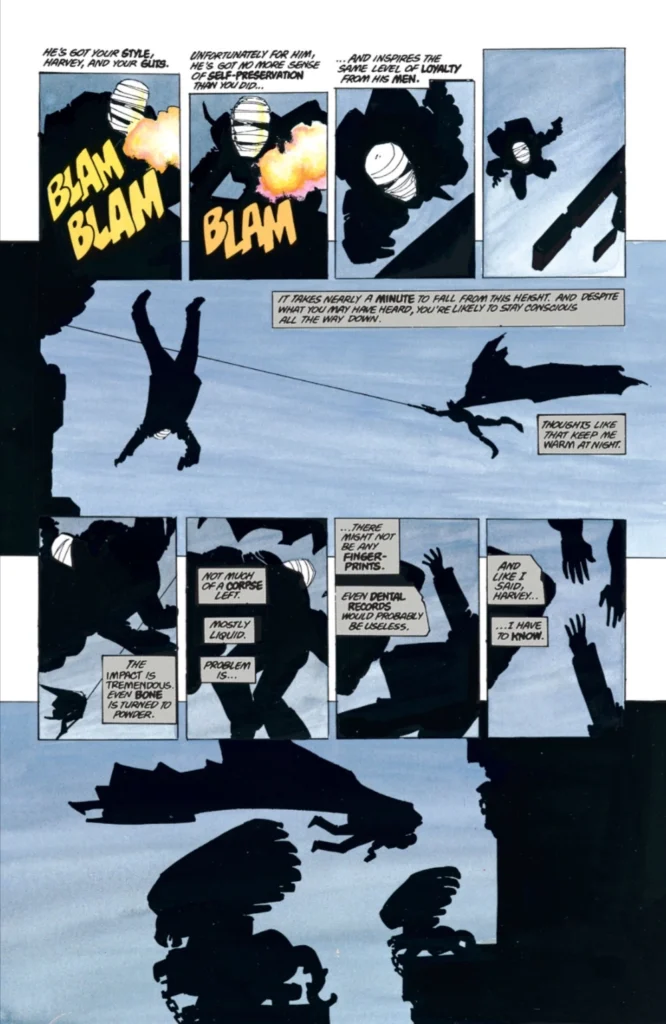
From Batman: the Dark Knight Returns book one. © DC Comics.
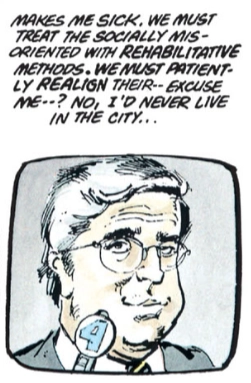
Another element that resonates more in 2024 than it did in 1986 is Miller’s clear disdain for what in the ‘80s would have been called “bleeding heart liberalism.” Attempts to coddle or rehabilitate the sociopaths that make up Batman’s gallery of villains always end in disaster, and the characters who enable this are portrayed as contemptible caricatures Miller’s Batman comes off as cynical, world-weary, and terrifyingly confident in his physical abilities, and he’s certainly not above using bullying and intimidation to get what he wants, with little to no regard for the law. This is very much a story about a man who has to stand up and take charge after the constructs of civilized society have utterly failed.
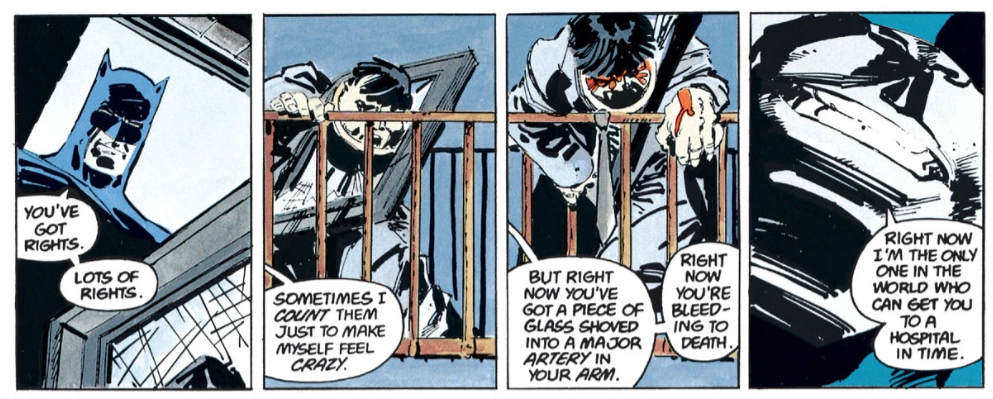
From Batman: the Dark Knight Returns book one. © DC Comics.
At the same time, the final page finds Batman admitting to Two-Face that he may be just as monstrous and irredeemable as his adversary. Miller doesn’t seem entirely convinced that Batman’s vigilante approach is any better.
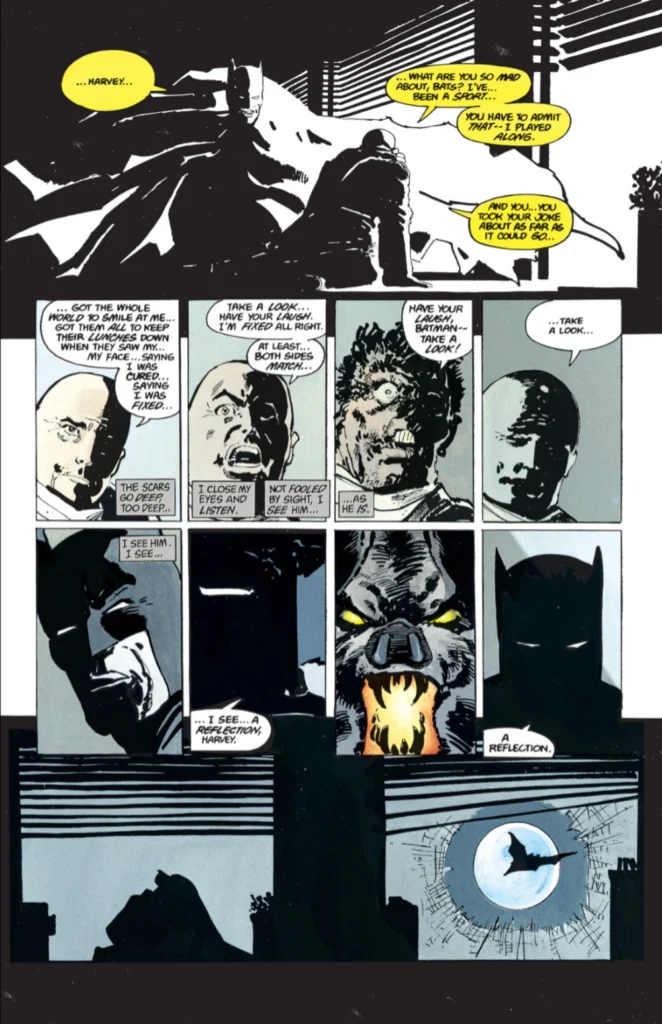
From Batman: the Dark Knight Returns book one. © DC Comics.
March 1986
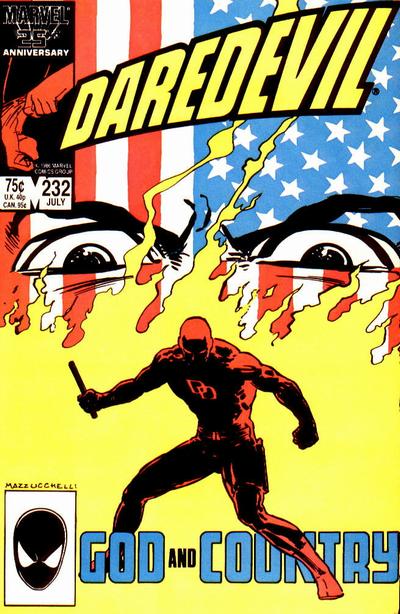
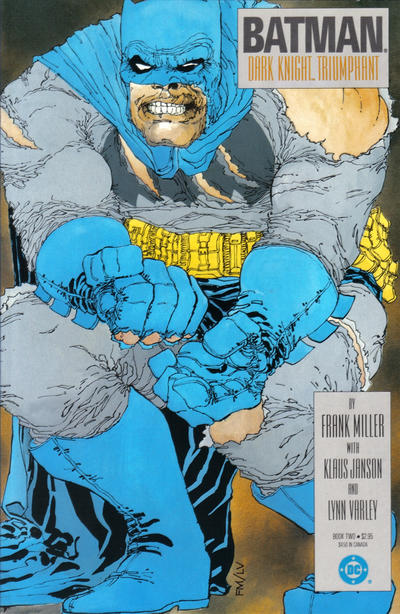
Daredevil #232 (cover date July 1986) “God and Country”
Story by Frank Miller; artwork by Dave Mazzucchelli; color by Max Scheele; letters by Joe Rosen.
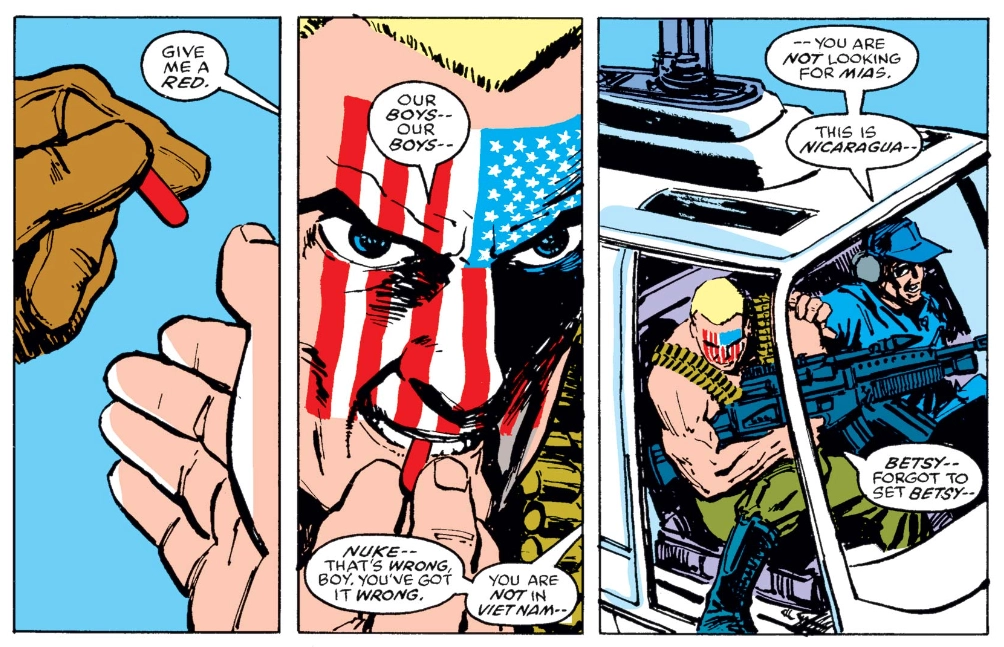
From Daredevil #232. © Marvel.
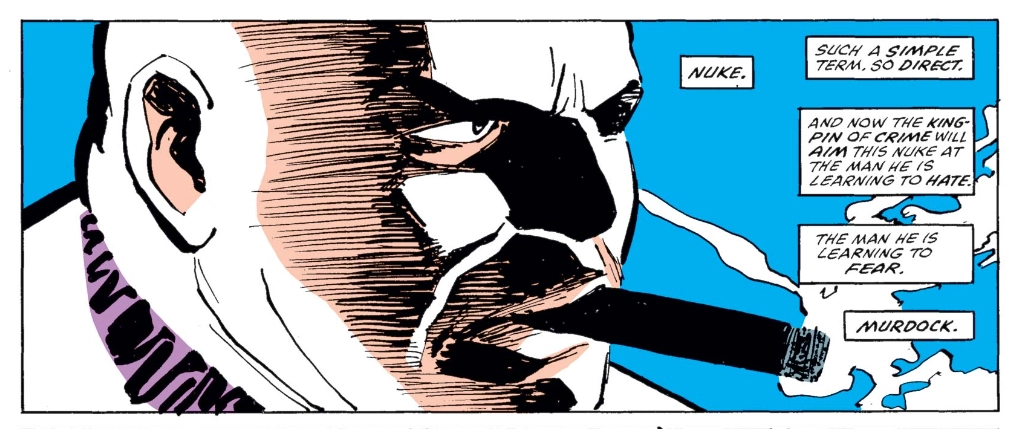
From Daredevil #232, © Marvel.
Matt Murdock, on the other hand, appears to have accepted, even embraced, his newfound simple life. He works as a cook in a greasy-spoon diner, which his superhuman senses of taste and smell make him very good at. He’s also helping Karen Page kick her heroin habit, and there seems to be no question that she should be punished or even blamed for betraying Murdock’s secret to the Kingpin – at worst she is portrayed as a sympathetic victim of circumstance, which is mildly surprising given Miller’s apparent stance on liberal rhetoric that seeks to excuse criminal behavior, especially apparent in The Dark Knight Returns. Along with the subplot involving Foggy Nelson and Matt’s ex-girlfriend Glory, the romantic story between Matt and Karen is uncharacteristically sweet, especially given the complete lack of any romance in The Dark Knight Returns, and the twisted relationship we will shortly see on display in Elektra: Assassin.
In a somewhat disturbing prediction of future politics, the Kingpin uses false patriotic rhetoric to get Nuke worked up, priming him for an all-out assault on Hell’s Kitchen. The ruse works, and Daredevil arrives for the inevitable showdown, appearing in costume for the first time in 5 issues. It’s a highly cinematic, action-packed sequence, superbly illustrated by Mazzucchelli.
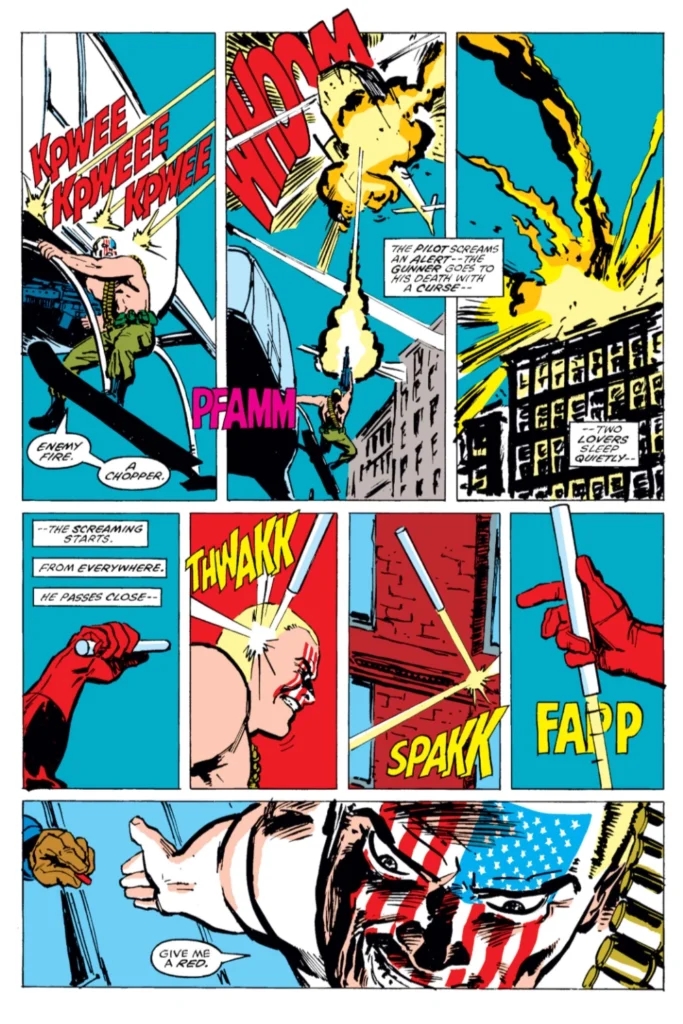
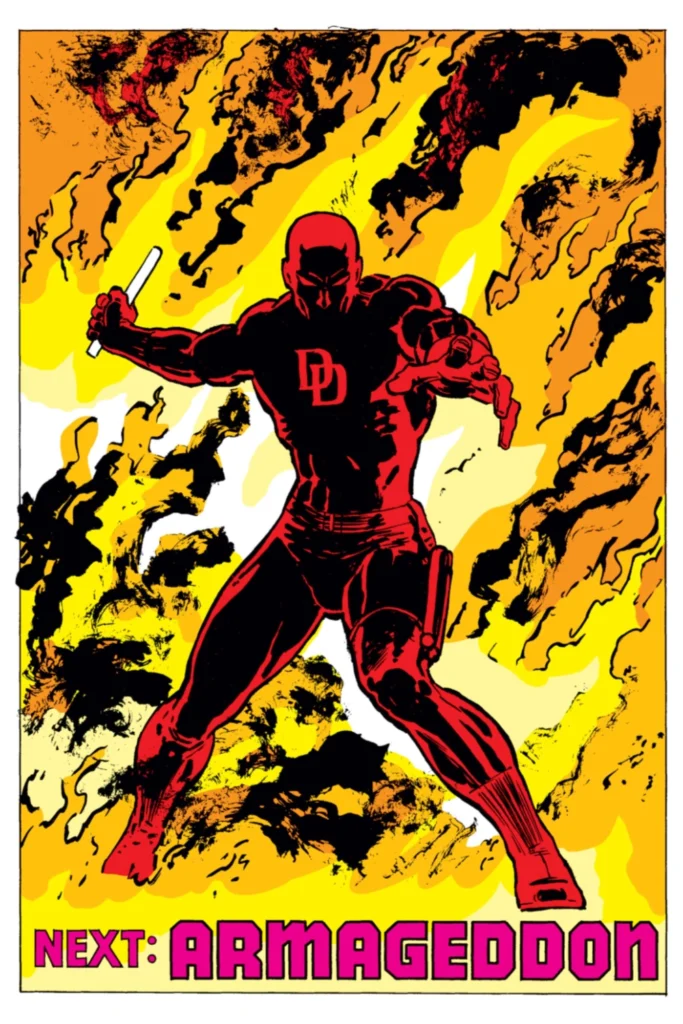
Daredevil #232 pages 21 and 22. © Marvel.
Batman: the Dark Knight Returns Book Two “Dark Knight Triumphant”
Story and pencils by Frank Miller; inks by Klaus Janson; colored by Lynn Varley; letters by John Costanza.
The cover to The Dark Knight Returns book two is seemingly at odds with the other three books in the series. Where the other covers are all very minimalist, using silhouettes and sparse illustrations, this one features a highly detailed image of a Batman who has clearly just been beat to hell, with torn costume and bruised face. It’s almost overdrawn and a little grotesque, but it does give a good preview of the brutality we’re about to see in this issue.
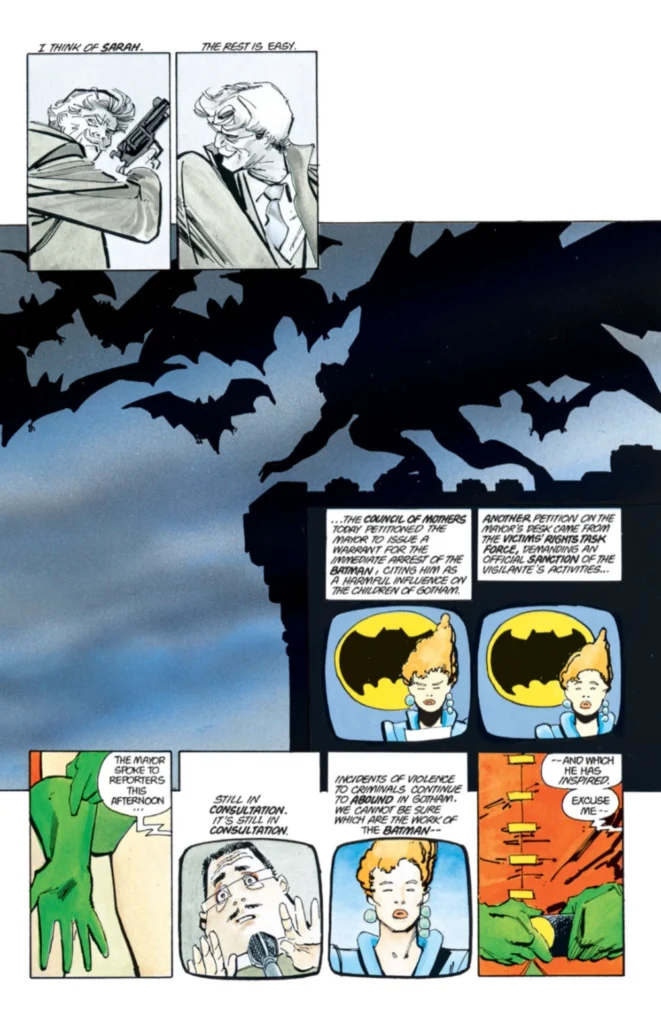
From Batman: the Dark Knight Returns book two. © DC Comics.
The focus in this issue is squarely on the effect the Dark Knight’s return has had on Gotham City. Miller makes brilliant use of small TV screen panels to give a lot of exposition when he needs to pull back from the more intimate points of view he gives us from Batman, Commissioner Gordon, and Carrie Kelley, a teenager who is inspired to become the new Robin. While crime in Gotham City has gone down, the more extreme criminal gang known as the Mutants appear to have been emboldened by Batman’s return. They attack citizens with impunity, illustrating why Gotham needed Batman to come back, but also posing the question hinted at in the fight with Two-Face and the end of book one: does Batman create the very problems he’s supposedly there to solve?
Throughout the issue, Batman continues to demonstrate that he has a bit of a mean streak, and he let’s his pride and arrogance gets the better of him when he chooses to confront the leader of the Mutants face-to-face. Robin, who hasn’t yet met Batman and is watching the fight from hiding, jumps in to help, which is the only thing that saves him from getting killed.
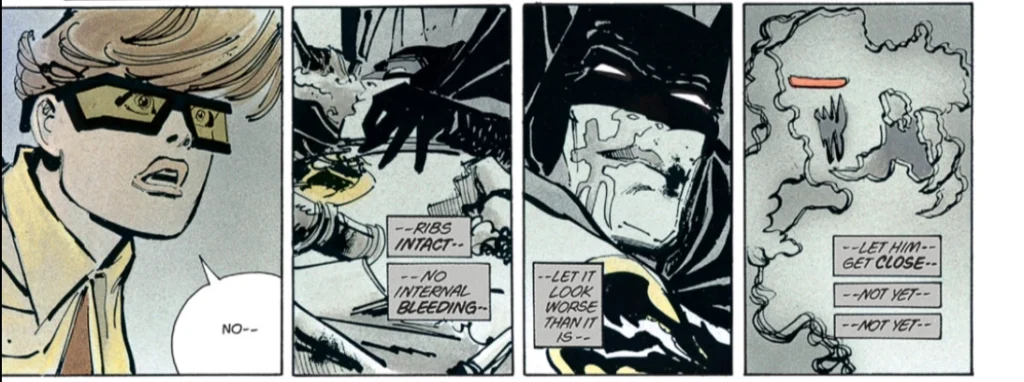
From Batman: the Dark Knight Returns book two. © DC Comics.
Miller continues to intercut scenes showing the effect, both positive and negative, that Batman’s return is having on the city. For some his presence acts as a catalyst to bring their insanity out into the open, but for others, he seems to embolden them to stand up for themselves against the crime and corruption that has overrun the city. We also see the start of a few plot threads concerning the Joker and Superman that will pay off in later issues.
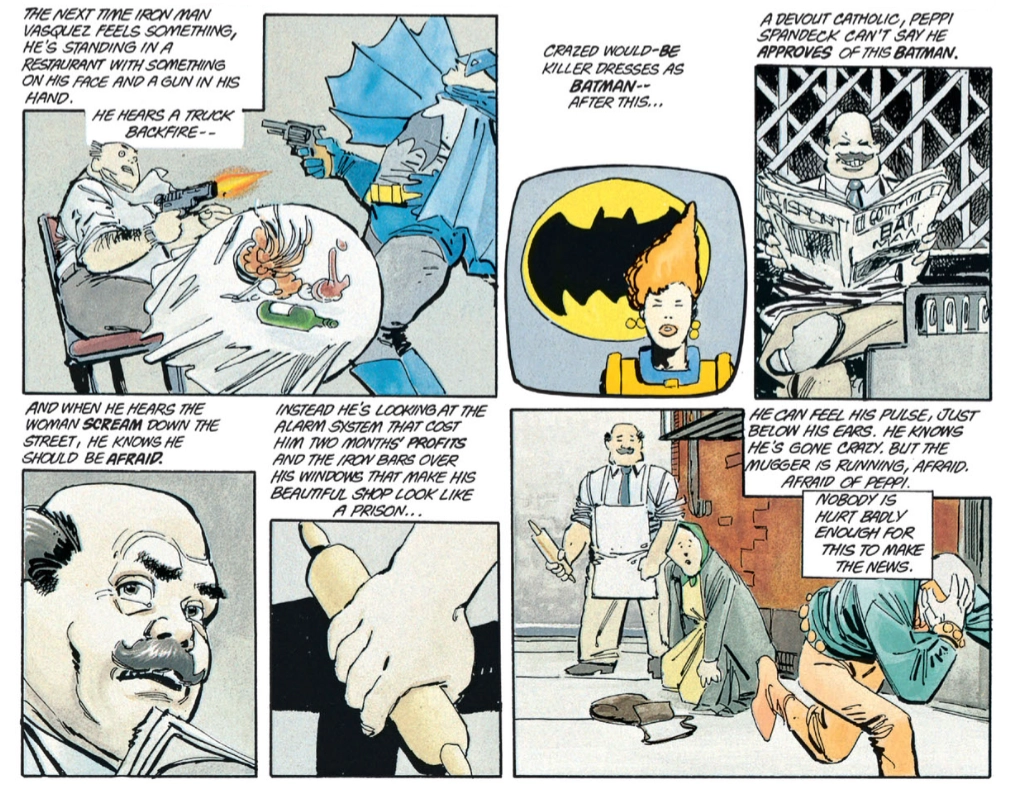
This issue ends with a rematch between Batman and the leader of the Mutants. With Gordon’s help, Batman reasons that the only way to stop the Mutants is to humiliate their leader by defeating him. He sets up a battleground that will neutralize his opponent’s superior speed and strength, and arranges for the rest of the Mutants gang to be there to see it. In a comment on media manipulation and the follower mentality, Batman’s victory results in many of the Mutants switching sides and forming what amounts to a cult in his honor…
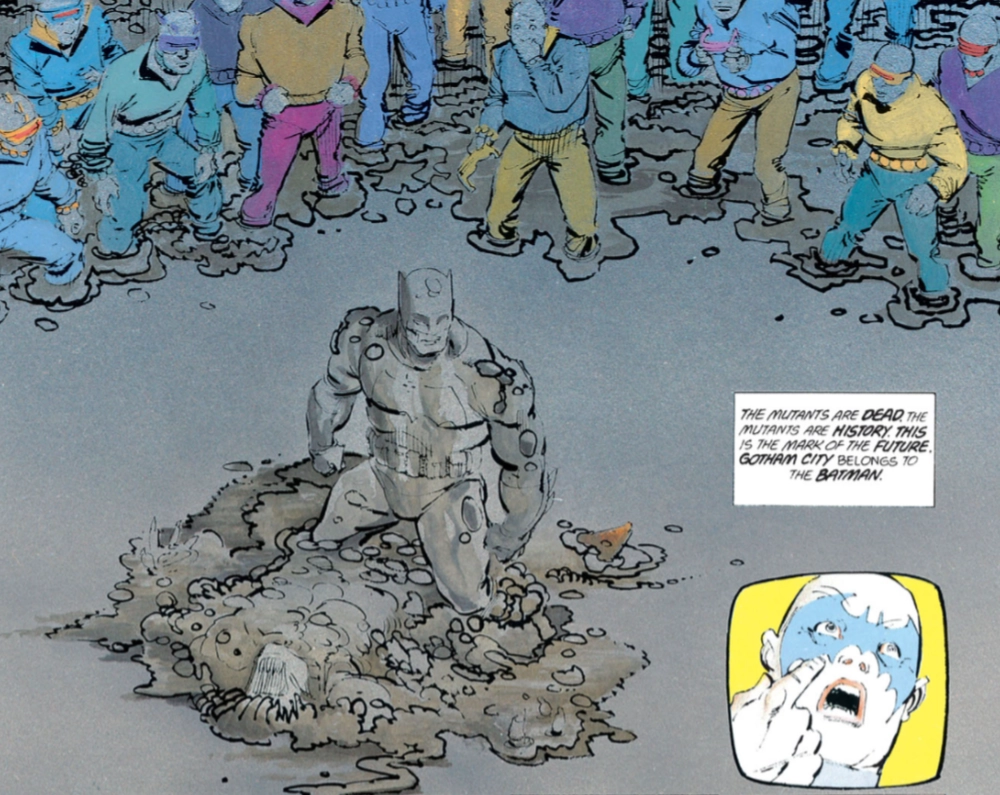
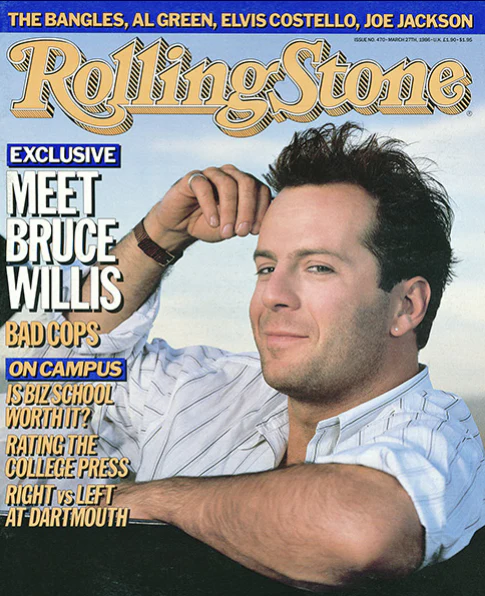
Rolling Stone #470 “Comic Genius”
Interview with Frank Miller by Mikal Gilmore
In addition to the penultimate chapter of “Born Again” and the second part of The Dark Knight Returns, March 1986 was the month that Frank Miller’s famous Rolling Stone interview came out. Read more about it here.
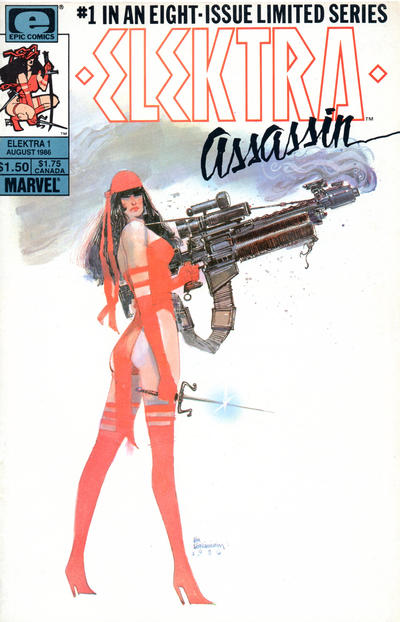
Next time:
Born Again concludes, The Dark Knight Returns continues, and things get weird with Elektra: Assassin…
Elektra: Assassin #1 cover art by Bill Sienkiewicz. © Marvel.
